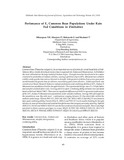Please use this identifier to cite or link to this item:
https://cris.library.msu.ac.zw//handle/11408/478Full metadata record
| DC Field | Value | Language |
|---|---|---|
| dc.contributor.author | Mharapara, T. R. | - |
| dc.contributor.author | Manjeru, Pepukai | - |
| dc.contributor.author | Makunde, G. | - |
| dc.contributor.author | Madanzi, Tendai | - |
| dc.date.accessioned | 2014-10-15T14:27:39Z | - |
| dc.date.available | 2014-10-15T14:27:39Z | - |
| dc.date.issued | 2012 | - |
| dc.identifier.issn | 1992-0903 | - |
| dc.identifier.uri | http://hdl.handle.net/11408/478 | - |
| dc.description.abstract | Common bean (Phaseolus vulgaris L.) is an important source of protein for cereal-based diets of Sub- Saharan Africa. Genetic diversity of common bean is organised into Andean and Mesoamerican. In Zimbabwe the most cultivated are the large seeded of Andean origin. Drought stress has been found to be a major constraint to production of Andean cultivars, causing a yield loss of up to 60%. Mesoamerican cultivars exhibit a wide genetic base and are tolerant to drought. Introgression of alleles from across gene pools would broaden the genetic base of cultivars, maximising gains from selection. A field experiment was carried out at Harare Research Station to evaluate performance and combining abilities of 25 F3 Andean X Mesoamerican populations bred for drought tolerance. The experimental design was a 5 x 5 triple lattice and each plot consisted of four rows, 3 m long and 0.5 m apart. Combining ability estimates were calculated based on Beil and Atkins (1967). There were no significant differences (p>0.05) in agronomic performance of the 25 F3 Andean X Mesoamerican populations under rain fed conditions. Average 100 seed weight for the populations was 30g with most combinations ranging between 25-33g,which falls within the medium seeded range. Parents PAN 127, PAN 148, SUG 131, SER 8, SER 22 and SEQ 11 were found to have good combining ability. Parents SEQ 11, SER 22 and PAN 127 can be used in breeding for drought tolerance in areas of intermittent and terminal drought because their progeny were early maturing. Hybrids SER22 X CAL143 and SER8 X SUG131 were the best combiners for pod and seed yield. There is also high potential to obtain superior genotypes in crosses SEQ11 X PAN 148, SER16 X SUG131, SEC16 X SUG131, SEC16 X PAN148, SER22 X PAN127, SEQ11 X CAL143 and SER16 X SUG131. | en_US |
| dc.language.iso | en | en_US |
| dc.publisher | Midlands State University | en_US |
| dc.relation.ispartofseries | Midlands State University Journal of Science Agriculture and Technology;Vol. 3(1) | - |
| dc.subject | Common bean | en_US |
| dc.title | Perfomance of F3 common bean populations under rain fed conditions in Zimbabwe | en_US |
| dc.type | Article | en_US |
| item.openairecristype | http://purl.org/coar/resource_type/c_18cf | - |
| item.grantfulltext | open | - |
| item.languageiso639-1 | en | - |
| item.fulltext | With Fulltext | - |
| item.openairetype | Article | - |
| item.cerifentitytype | Publications | - |
| Appears in Collections: | Research Papers | |
Files in This Item:
| File | Description | Size | Format | |
|---|---|---|---|---|
| manjeru.pdf | 195.58 kB | Adobe PDF |  View/Open |
Items in MSUIR are protected by copyright, with all rights reserved, unless otherwise indicated.



